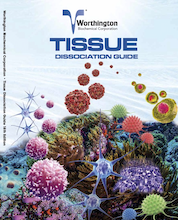For our international customers, please be advised that orders cannot be placed through our website by customers in countries with International Distributor representation.
Worthington Tissue Dissociation Guide
Methods and Materials: Cell Release Procedure
In order to transfer or pass cells in monolayer culture from one culture vessel to another it is necessary to release cells from the monolayer into suspension so that they can be easily handled by pipetting and diluting.
Releasing cells from the monolayer is almost always accomplished with purified trypsin by a procedure known as trypsinization. A usual trypsinization procedure is detailed in the inset below.
|
Some researchers have found that procedures using crystalline trypsin can provide increased viability in cells after they are released. Viability is usually determined by measuring cloning efficiency, i.e., the ability of a single cell to attach to the wall of a culture vessel and divide to produce a colony of cells which is visible to the naked eye after staining.
Tissue Tables
The Worthington Tissue Tables provide references useful to researchers interested in tissue dissociation and cell harvesting procedures. The references are organized by Tissue and Species type and linked to PubMed citations. The Cell type, Enzymes, and Medium for each reference is provided.
To search by specific criteria, use the Tissue References Search Tool.
